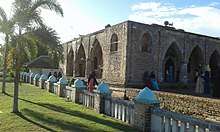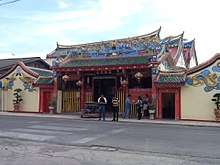Lin Daoqian
| Lin Daoqian | |
|---|---|
| Native name | 林道乾 |
| Born |
16th century Teoswa region, Guangdong, Ming China |
| Died |
unknown Patani, Siam |
| Occupation | Pirate |
Lin Daoqian (Chinese: 林道乾; pinyin: Lín Dàoqián; Wade–Giles: Lin Tao-ch'ien; Pe̍h-ōe-jī: Lîm tō-khiân, Malay: Tok Kayan, Thai: ลิ้มโต๊ะเคี่ยม), also written as Lim Toh Khiam and Vintoquián,[1][2] was a Chinese pirate and trader of Teochew origin. He led pirate attacks along the coast of Guangdong and Fujian, but they were driven to Taiwan by the Ming dynasty navy commanded by Yu Dayou. He later moved to South East Asia where he traded and engaged in piracy. He became established in Patani where he died.[3]
Life
Lin was of Teochew origin, and he was described as being from either Chenghai or Huilai in Guangdong.[4][5] Later he moved to Quanzhou, Fujian.[6] Lin was part of the wokou piratical activity that plagued the Chinese coast during the reign of the Ming Jiajing Emperor (1522–1566). He attacked Zhao'an in 1563, where he was said to have burnt hundreds of houses killing thousands.[3] In response, the Ming navy led by Yu Dayou drove Lin away first to Penghu islands, later to Beigang, Taiwan. Yu then occupied Penghu, but did not pursue Lin to Taiwan.[7] Lin was said to have stayed in Takau for a while . According to Taiwanese accounts, Lin slaughtered many of the natives in Taiwan, using their blood as caulk for his ships.[8]
Lin escaped to Champa, but after another defeat, he went to Luzon in the Philippines.[1] By 1567, he was again raiding along the coast of China, and in 1568, and the Ming authority placed a bounty on Lin in an attempt to capture him.[9] Lin was reported to have 5,000 followers in July 1569.[10] At some point he was said to have been attacked by another pirate chief Lin Feng, who captured 55 of his ships.[11] Ming records state that Lin was "most crafty and cunning",[12] and would alternately rebel and swear allegiance to the Ming authority.[13] It was reported in 1573 that he had rebelled, and fled to find sanctuary in a foreign country.[14] He settled in Pulo Condore in 1574.[10]

By the first half of 1570s, Lin was already operating in the Patani area, and the Ming authority joined force with the Siamese navy as well as using Portuguese ships to combat the pirates.[15] In 1578, he established a base in Patani with 2,000 followers and they would dominate the town for some time.[16] Ming sources indicate that he attacked Siamese ships but was repelled in 1578, and in 1580 he again attacked Siam but also left Siam later that year.[17] The Ming authorities tried to capture him while he continued to launch raids against Chinese ships in 1580–81. After 1581 there were no further reports of his piratical activity in Ming sources, suggesting he had retired from raiding and settled in Patani. He obtained a fief and briefly established a small port near Patani, while members of his band gained prominence in the service of Patani's ruler.[10] According to the local lore of Patani, he married the daughter of the Sultan, converted to Islam and built a mosque. He died in Patani, said to be due to cannon fire while he was testing cannons he had made.[18]
Lore and legends
In Taiwan
There are a number of myths and legends about Lin in Taiwan. It was said that while anchored at Takau, Taiwan in 1563, Lin placed his treasure into eighteen and a half bamboo baskets, hiding them in the surrounding hills, and the Takau Hill then acquired an alternate name Buried-Gold Hill (埋金山). Another story goes that Lin was told by a Taoist master that he would be able to conquer all of China if, after he had performed certain tasks in a hundred days, he fired three arrows towards Beijing on the dawn of the last day. The master gave him 3 magic arrows and a "divine rooster". Lin handed the rooster in the care of his sister Jin-lien (金蓮). On the midnight of last day, Jin-lien inadvertently startled the rooster, causing it to crow. Lin awoke and mistakenly thought that dawn had arrived, immediately firing off three divine arrows with his name towards the imperial capital. The three arrows flew into the imperial palace, striking the dragon throne. However, as it was midnight, the throne was empty. The emperor found the three arrows with Lin's name on them stuck in his throne, realizing that Lin had attempted to kill him, then ordered his troops to attack Lin.[19]
In Patani

The Teochew people of Thailand tell a number of stories about Lin. In one, he was said to have helped the Siamese fight off an Annam attack and was thus given the daughter of the king to marry; however, he later angered the king after making a joke about killing the king, and had to flee.[18] Another story involves the legend of Lin Guniang (Lim Ko Niao), said to be his sister in this account. Lin Guniang tried to persuade her brother to return to China with her after finding that her brother had married a local woman, converted to Islam as well as building a mosque in Kru Se, Patani. However he refused, fought and defeated her, and she then committed suicide by hanging from a tree.[10] Her gravestone, located next to the Krue Se Mosque, is said to have been built by her brother. A shrine in her name exists in Patani and she is worshipped by some Chinese people in southern Thailand.[6][20]
According to Phongsawadan muang pattani (Chronicle of Pattani), he attempted to cast three bronze cannons to be used in the wars of Patani. After several failures with the third cannon, he offered to sacrifice himself should his attempt be successful, and was blown up while testing the third cannon.[18] A 19th century Chinese account claims that the ruler of Patani was his descendant.[21]
Legacy
It is thought that Lin's activity in the area may have influenced the migration of Teochew people to Thailand in later years.[4] A Dutch merchant Olivier van Noort described a group of traders from Patani he met in Brunei in 1601 as being Chinese enough to have their own king and used the same laws as in China.[22] Another Dutch report of 1603 by Jacob van Neck estimated that there may be as many Chinese in Patani as there were native Malays.[23] Many Malays in Kru Se, Patani claim descent from Lin, although they may have been descendants of his followers who married local women.[18]
References
- 1 2 Igawa Kenji (1 June 2010). Robert J. Antony, ed. Elusive Pirates, Pervasive Smugglers: Violence and Clandestine Trade in the Greater China Seas. Hong Kong University Press. p. 80. ISBN 978-9888028115.
- ↑ Patrick Jory. "From Melayu Patani to Thai Muslim: The spectre of ethnic identity in southern Thailand". South East Asia Research. 15 (2): 255–279. JSTOR 23750846.
- 1 2 Graham Gerard Ong-Webb, eds. (30 June 2007). Piracy, Maritime Terrorism and Securing the Malacca Straits. ISEAS Publishing. p. 236. ISBN 978-9812304179.
- 1 2 Yen Ching-hwang. Ethnic Chinese Business In Asia: History, Culture And Business Enterprise. World Scientific Publishing Company. p. 57. ISBN 9789814578448.
- ↑ Yow Cheun Hoe (2013). Guangdong and Chinese Diaspora: The Changing Landscape of Qiaoxiang. Routledge. ISBN 9781136171192.
- 1 2 Tamaki, Mitsuko (December 2007). "The prevalence of the worship of Goddess Lin Guniang by the ethnic Chinese in southern Thailand" (PDF). G-SEC Working Paper. Global Security Research Institute. 22.
- ↑ Wong Young-tsu (2017). "Unrest on the China Coast". China’s Conquest of Taiwan in the Seventeenth Century. Springer, Singapore. p. 25. doi:10.1007/978-981-10-2248-7_2. ISBN 978-981-10-2248-7.
- ↑ Camille Imbault-Huart (1893). L'île Formose : histoire et description. p. 5.
- ↑ "Long-qing: Year 2, Month 9, Day 29". Southeast Asia in the Ming Shi-lu: an open access resource. Translated by Geoff Wade. Asia Research Institute and the Singapore E-Press, National University of Singapore.
- 1 2 3 4 Francis R. Bradley (2008). "Piracy, Smuggling, and Trade in the Rise of Patani, 1490–1600" (PDF). Journal of the Siam Society. 96: 27–50.
- ↑ Mendoza's Historie of the Kingdome of China, Volume 2. p. 7.
- ↑ "LLong-qing: Year 3, Month 7, Day 23". Southeast Asia in the Ming Shi-lu: an open access resource. Translated by Geoff Wade. Asia Research Institute and the Singapore E-Press, National University of Singapore.
- ↑ "Long-qing: Year 3, Month 6, Day 1". Southeast Asia in the Ming Shi-lu: an open access resource. Translated by Geoff Wade. Asia Research Institute and the Singapore E-Press, National University of Singapore.
- ↑ "Wan-li: Year 1, Month 5, Day 14". Southeast Asia in the Ming Shi-lu: an open access resource. Translated by Geoff Wade. Asia Research Institute and the Singapore E-Press, National University of Singapore.
- ↑ Geoff Wade (30 August 2013). Patrick Jory, ed. Ghosts of the Past in Southern Thailand: Essays on the History and Historiography of Patani. NUS Press. pp. 67&ndash, 69. ISBN 978-9971696351.
- ↑ Anthony Reid (30 August 2013). Patrick Jory, ed. Ghosts of the Past in Southern Thailand: Essays on the History and Historiography of Patani. NUS Press. p. 7. ISBN 978-9971696351.
- ↑ Geoff Wade (September 2000). "The "Ming shi-lu" as a Source for Thai History: Fourteenth to Seventeenth Centuries". Journal of Southeast Asian Studies. 31 (No. 2): 249–294. JSTOR 20072252.
- 1 2 3 4 Geoff Wade (2004). "From Chaiya to Pahang: The Eastern Seaboard of the Peninsula in Classical Chinese Texts". In Daniel Perret. Études sur l'histoire du sultanat de Patani. École française d'Extrême-Orient. pp. 75–78.
- ↑ 雪珥. 大國海盜. pp. 87&ndash, 88. ISBN 9789573272069.
- ↑ Anthony Reid (30 August 2013). Patrick Jory, ed. Ghosts of the Past in Southern Thailand: Essays on the History and Historiography of Patani. NUS Press. pp. 12–13. ISBN 978-9971696351.
- ↑ Geoff Wade (30 August 2013). Patrick Jory, ed. Ghosts of the Past in Southern Thailand: Essays on the History and Historiography of Patani. NUS Press. pp. 75–76. ISBN 978-9971696351.
- ↑ Anthony Reid (30 August 2013). Patrick Jory, ed. Ghosts of the Past in Southern Thailand: Essays on the History and Historiography of Patani. NUS Press. p. 20. ISBN 978-9971696351.
- ↑ Anthony Reid (30 August 2013). Patrick Jory, ed. Ghosts of the Past in Southern Thailand: Essays on the History and Historiography of Patani. NUS Press. pp. 22–23. ISBN 978-9971696351.